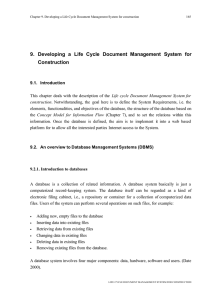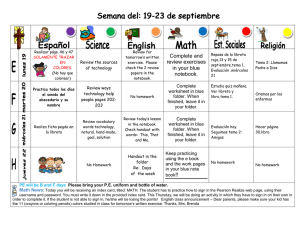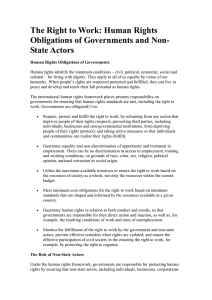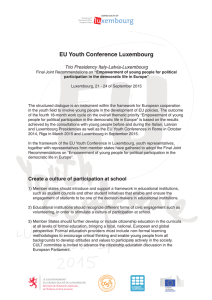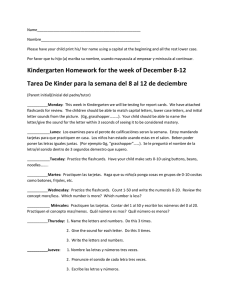8. Developing guidelines for Document Management through
Anuncio
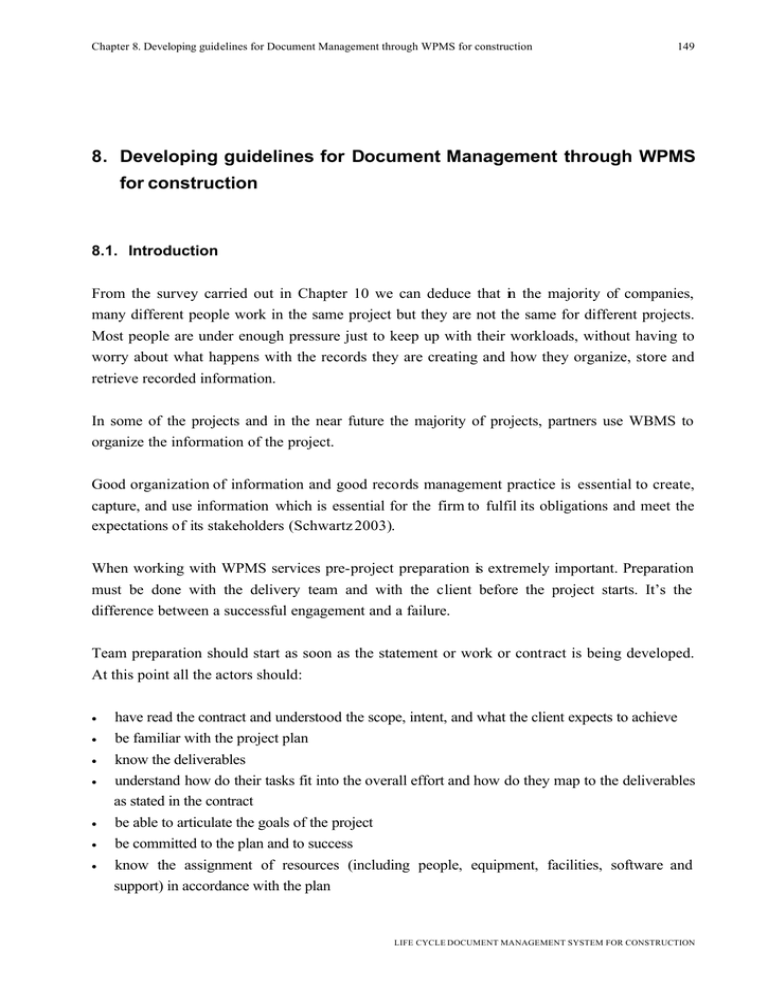
Chapter 8. Developing guidelines for Document Management through WPMS for construction 149 8. Developing guidelines for Document Management through WPMS for construction 8.1. Introduction From the survey carried out in Chapter 10 we can deduce that in the majority of companies, many different people work in the same project but they are not the same for different projects. Most people are under enough pressure just to keep up with their workloads, without having to worry about what happens with the records they are creating and how they organize, store and retrieve recorded information. In some of the projects and in the near future the majority of projects, partners use WBMS to organize the information of the project. Good organization of information and good records management practice is essential to create, capture, and use information which is essential for the firm to fulfil its obligations and meet the expectations of its stakeholders (Schwartz 2003). When working with WPMS services pre-project preparation is extremely important. Preparation must be done with the delivery team and with the client before the project starts. It’s the difference between a successful engagement and a failure. Team preparation should start as soon as the statement or work or contract is being developed. At this point all the actors should: • • • • • • • have read the contract and understood the scope, intent, and what the client expects to achieve be familiar with the project plan know the deliverables understand how do their tasks fit into the overall effort and how do they map to the deliverables as stated in the contract be able to articulate the goals of the project be committed to the plan and to success know the assignment of resources (including people, equipment, facilities, software and support) in accordance with the plan LIFE CYCLE DOCUMENT MANAGEMENT SYSTEM FOR CONSTRUCTION 150 Chapter 8. Developing guidelines for Document Management through WPMS for construction This chapter will expose a proposal of guidelines to help all the companies taking part in a construction project and basically those that are working using WPMS to organize their documentation and to facilitate the integration and transfer of their documentation to the WPMS. 8.2. Proposal of guidelines for Document Management Once all the partners that will take part of the project and will be using WPMS are accepted and approved for using these services, it’s necessary to define standards to work on the WPMS. Each WPMS has its own procedures and they train their customers to use all the available and specific tools of the platform, e.g. calendar, chat, webcam, etc. These guidelines proposed in this thesis are for the document management and the organization of information. Before developing a Life cycle Document Management System for Construction it’s important to define a criterion to organize the project information both internally and externally. The use of this guidelines must help all kind of companies to organize all kind of information related to a project. These guidelines are based on International Organization Standardization (ISO) standards. LIFE CYCLE DOCUMENT MANAGEMENT SYSTEM FOR CONSTRUCTION Chapter 8. Developing guidelines for Document Management through WPMS for construction 151 Guidelines for Document Management through Web Based Project Management Systems for construction. LIFE CYCLE DOCUMENT MANAGEMENT SYSTEM FOR CONSTRUCTION 152 Chapter 8. Developing guidelines for Document Management through WPMS for construction Guidelines for Document Management through Web Based Project Management Systems for construction. 1. Background Collaboration through Internet promises to help synchronize designing and building activities around the world in order to provide better quality and shorter time-to-market. Existing and start-up companies created hundreds of new applications and services during the past few years to leverage the Internet for design/build activities alone. Each firm invested a tremendous amount of money, but many of the business plans proved to be unfeasible. On top of that, with so many applications to choose from, building your own doesn’t make sense. AEC firms tend to be involved in a portion of the building process. They team up in different combinations for different projects. AEC firms typically have far less optimized work processes, and they have invested far less in computer technology. However, the final product (a building or a plant) requires ongoing management that is affected by the quality of the information provided to run it. Internet collaboration tools can affect a significant paradigm shift in AEC by unifying the disparate project teams of architecture, construction and owner/operator for the first time ever. Web based Project Management Systems can act as a breeding ground for true integration between discrete processes of all major participants in the industry. By themselves, they may save only a small portion of efficiency throughout the entire life cycle of a building, but they are a critical first step for our industry to begin truly integrating data such as legacy, and in-house applications and systems. Successful WPMS requires that all project team members understand how to use the technology, are comfortable with it, and actually use it to manage projects. In order for WPMS to work, multiple groups and departments inside and outside the company (engineering, purchasing, manufacturing, and vendors) are involved. In the majority of AEC companies, many different people work in the same project but they are not the same for different projects. Most people are under enough pressure just to keep up with their workloads, without having to worry about what happens with the records they are creating and how they organize, store, and retrieve recorded information. Some companies have a Quality Management System, others do not; some are used to exchange information through the web, others are not; some have a well established documental organization, others have not, etc. The main problem is how each participant deals with his/her data and how the management of his/her enterprise can be compatible with the management of a project. Since each firm might be involved in many other projects, it’s necessary to have a common basis for all organizations. Because of this heterogeneous market, these Guidelines will provide a tool for those SMEs involved in WPMS with the aim to improve their internal document management so as to be able to interact with whatever WPMS. These guidelines are applicable to projects of varying complexity, size and duration, and adaptable to national, local and project-specific variations of the building process. LIFE CYCLE DOCUMENT MANAGEMENT SYSTEM FOR CONSTRUCTION Chapter 8. Developing guidelines for Document Management through WPMS for construction 153 2. Scope The main objective of these guidelines is to provide a concise way of (internal and external) document management for the internal use by all the colleagues within the company, and outside the company among the other partners of the project using the same Web Based Project Management System. These guidelines cover the whole life cycle of a construction project and are intended to be used by all the partners that take part in a construction project: client, designer and contractor. 3. Terms and definitions 3.1. activity working area of the project. 3.2. actor person or company who carries out the processes occurring in relation to the life cycle of a project. 3.3. attribute format of the document. 3.4. description of a document set of information of special relevance to the understanding of the document. 3.5. document metadata set of properties which describes and identifies the document, such as name, description, date, etc. 3.6. document name characters by which a document is known. 3.7. late submittal date Phase and Stage where the Document must be submitted for the right functioning of the project. 3.8. project phase period of a construction project, identified by the overall character of the processes which occur within it. 3.9. project stage sub-process of the project phase, in which new build, refurbishment, repair or demolition work is executed. LIFE CYCLE DOCUMENT MANAGEMENT SYSTEM FOR CONSTRUCTION 154 Chapter 8. Developing guidelines for Document Management through WPMS for construction 3.10. related Documents extra documents necessary for the entire understanding of the document. 3.11. responsibility document-related function actually performed by an actor. The responsibilities can be Create or Receive. 3.12. Role function actually fulfilled by an actor in a project. 3.13. Subactivity type of information of special importance within a project. 3.14. type of document document-related metadata regarding the stored information. 4. Document codification 4.1. Scope For a good development and functioning of WPMS, a homogenization of the structure and nomenclature of the documents from each actor is required. When the document name is well defined, every actor can understand, search, consult and use these documents easily. All the actors should obey the same rules of document nomenclature in order to centralize them and avoid information duplication. 4.2. General structure vs. Particular structure All the actors, depending on their having a Quality System or not, will have a predefined information structure that could not be adapted to the whole document structure of the WBPM. It’s necessary to homogenize the structure for to automate whatever task related to the external management of the project. It might be beneficial and necessary to restructure the internal archive and document nomenclature to facilitate the use of this information when an external system such as a WPMS requires it. For those companies that still don’t have any quality system, this is the moment to define their internal and external organization and nomenclature of archives. 4.3. Compatibilities between actors A WPMS is a temporal enterprise formed by a group of subcompanies that work together to carry out an objective, i.e. the project. LIFE CYCLE DOCUMENT MANAGEMENT SYSTEM FOR CONSTRUCTION Chapter 8. Developing guidelines for Document Management through WPMS for construction 155 It’s important to have a common preestablished organization and functioning to improve the efficiency of the group. When the projects comes to an end, this company terminates. 4.4. Codification Each Document name should be formed by 2letters+3numbers+4letters+4numbers. The first two letters concern the name of the project. They are the two first letters of the project. If there is another project with the same two first letters, you should change it into the first and third letters. The first three numbers concern a consecutive relation of Documents with the same characteristics. The following two letters concern the initials of the type of the Document and are written in capital letters. The last two letters concern the initials of the attribute of Document and should be in small letters. The last four numbers are the latest publication, revision, or modification date. The first two numbers are the year and the others are the month. rd EXAMPLE: The Document name of a Site Note of the Forum project modified on the 3 of November 2002 will be: FO001SNdc0211. For templates of documents, a ‘t’ after the attribute should be included. For provisional or unfinished documents not uploaded yet in the WPMS, a ‘p’ after the attribute should be included. For obsolete documents, an ‘o’ after the attribute should be included. 5. Organization of folders and documents 5.1. Scope For a good functioning of the WPMS and also for the achievement of the project objectives, all actors and all individuals working as actors developing whatever role in the project should have a well structure organization of documentation. The most traditional way and the easiest way for those companies or individuals who are not very keen on IT is to organize the information in folders like Windows explorer. Another important aspect is to have the same folder structure as the WPMS folder structure. It doesn’t matter the visualization method of the WPMS but how information is stored. 5.2. WPMS’ organization vs. company’s organization Each WPMS has the functionalities of searching, viewing, revision and versioning control, document relationships, status reporting, issue and distribution management, remote access, etc. On the contrary, many SMEs organize the information in an untidy way and using only folder structures from the Windows explorer. LIFE CYCLE DOCUMENT MANAGEMENT SYSTEM FOR CONSTRUCTION 156 Chapter 8. Developing guidelines for Document Management through WPMS for construction It is necessary to link these two organizational structures by uploading and downloading the precise information and tracking well what has been uploaded and downloaded. 5.3. Folder structure Each actor or individual partaking in a project and using WPMS must control all the information he/she creates and delivers. Actors are not free to create their own folder structure with invented folder and archive names. They should use the predefined organizational structure. To create the same folder structure, both in the company (PCs or in the server) and in the WPMS a ‘Life cycle Document Management System’ can be used. 5.4. Document templates Some firms might have templates for each document or for some documents. They must be stored in the same internal organizational structure as the other project information but with its correct name as a template. When any individual within the company must create a document, he/she must make sure whether the template exists or not. If the template exists it must be picked up, renamed using the correct nomenclature, and stored again in the adequate folder of the project. If it doesn’t, a new document must be created, named using the correct nomenclature, and stored in the adequate folder of the project. 5.5. Document management Each actor or individual partaking in a project and using WPMS must control all the information he/she creates and delivers. To track the whole project and information management between all the partners in a construction project, each WPMS has the functionalities of searching, viewing, revision and versioning control, document relationships, status reporting, issue and distribution management, remote access, etc. But it is also important to have an internal control of the documentation. To find the last version of a document each actor should search it in the WPMS. If the document is needed as a basis for creating another one, it must be downloaded into the company’s folder structure for that particular project work, used, renamed, and uploaded into the right folder of the WPMS. An individual can only upload finished documents. If an individual is working on a document which is not finished, he must store it in the company’s folder structure until it’s ready to be uploaded. LIFE CYCLE DOCUMENT MANAGEMENT SYSTEM FOR CONSTRUCTION Chapter 8. Developing guidelines for Document Management through WPMS for construction 157 6. Publication dates A Document can’t be published or uploaded if it’s not finished. Once an actor uploads a document into the WPMS, the system automatically creates extra metadata such as document type, revision document number (if it is the case), upload date, owner, author, etc. For internal control of uploaded documents, the individual who uploads one should change the name of the file and delete the ‘p’ (provisional) from the name of the document. Only the final versions of documents should be stored both in the company’s file structure and in the WPMS. It is not allowed to store different intermediate versions of documents. 7. Document metadata 7.1. Scope When using WPMS, different metadata might be asked to be incorporated when uploading a document. In order to cope with the issues of document indexing, search and retrieval, and reuse of documented and business information, the process of classification and metadata specification focuses on the selection of a set of labels representing contents as well as context-related properties of documents. When using the ‘Life cycle Document Management System,’ the documents required in a construction project will be automatically created together with extra metadata. In this case, actors will not need to fill in the information about the document by themselves. Other additional metadata will be created automatically by the WPMS. If the actor must create a document which is not in the ‘Life cycle Document Management System,’ or if he/she is not using this system, he/she will have to provide this extra information when uploading a document in the WPMS. 7.2. Content-related metadata Content metadata relates to what the document contains or is about, thus providing to users and applications useful hints to help document search and retrieval and to improve the reuse of documented information. Content-related metadata concerns the information about the document location in the project life cycle, e.g. Phase and Stage , Activity and Subactivity, and Actor. (See Annex A) Actually, phases and stages can overlap, so the idea of organizing the information into the life cycle of the project doesn’t mean that one stage succeeds the other; it’s only a way of defining processes into the construction project. The type and character of each activity and/or subactivity varies according to its temporal location within the life cycle of the project. Activities or subactivities generally overlap and are interactive. The fittest way to organize the tasks to be carried out by different stakeholders, is joining all the roles –e.g. architect, quality control consultant, S&H consultant, different specialize consultants, civil engineer, electrical engineer, etc.- into three categories of actors: Client, Designer and Contractor. LIFE CYCLE DOCUMENT MANAGEMENT SYSTEM FOR CONSTRUCTION 158 Chapter 8. Developing guidelines for Document Management through WPMS for construction So then, to create a generic system, whatever actor partaking in a construction project might be included in any of these three categories. Normally, we will have different companies or stakeholders developing different activities, but all of them grouped in just one; for example, the architect and the engineer might be working for different organizations but both of them are working as Designers. 7.3. Context-related metadata Context-related metadata express the ‘by whom, where, how, under which constraints and for which purpose’ a document is being accessed, transmitted and modified. Thus, the business information related to the practices of documents use is made explicit, promoting formalization, exchange and reuse of this valuable information. These document properties are divided into: Document name Description Late submittal date Responsibility Role Attribute Type of document Related Documents 8. Communication process Each actor has the duty to check mails, WPMS calendar, tasks and notices at least once a day. Each actor must answer the mail in a 2 days term after receiving it. If the necessary information lacks, he/she must answer the mail giving details on when the information will be delivered and the reasons of the delay. All the face to face communications should be registered in the WPMS together with the topic of the communication, the actors involved in it, and the agreements therein reached. LIFE CYCLE DOCUMENT MANAGEMENT SYSTEM FOR CONSTRUCTION Chapter 8. Developing guidelines for Document Management through WPMS for construction 159 9. Roles and responsibilities When focusing on the WPMS, all individuals in a company work as one actor, so the responsibility of the delays, errors, etc., will be global. On one side, a person might be in charge of uploading the information so he/she will be responsible for the document. On the other, different people within the same company might have responsibilities for uploading the documentation to the WPMS. In this case, the one who has uploaded the document is responsible for it. It depends upon the business philosophy. 10. Document control Every document should be controlled in order to: Approve the documents, if they are adequate, before publication Revise, improve or re-approve documents Identify the state of the actual versions of the documents Assure that the relevant revisions of documents are ready for use when necessary Assure that all documents are storable and easily readable and identifiable Assure that all the documents with external origin are identified and correctly stored Avoid the use of obsolete documents and give specific identification to them Be able to locate them fast and efficiently Correctly identify the obsolete documents that are stored for legal purposes Reedit the documents after some revisions LIFE CYCLE DOCUMENT MANAGEMENT SYSTEM FOR CONSTRUCTION 160 Chapter 8. Developing guidelines for Document Management through WPMS for construction Annex A. Classification of information Types of Documents and Attributes Id Type of Document Id Type of Attribute AD Administrative procedures md access Document .MDb dw DraWing Document .DWg Answers xl eXceL Document .XLs AP Approvals im IMage drawing .gif, .tiff, .jpg, bmp AW Awarding pp Power Point Document .PPt Budget hm web Document .HtMl, .HtM by-laws wp Win Project Document dc word Document .DoC AN AS BU BY Annexes CA Catalogues CE Certifications CH Change orders CR Communication reports CO Contract CP Control Plan DL Defects List DR Drawings FO Forms GD Generic documents IN Incidences IR Information requests IP Inspection Points IS Instruction IU Insurance IV Invoice LE Letters LI Licences MA Manual ME Measurements MT Meetings MM Memory MI Minutes NC Non-conformities OC Organization chart PA Payments PL Planning PR Procedures PO Programming RE Receipt RP Reports RT Request of tender SB Site Book SN Site Note SP Specifications TN Tenders TU Turnover LIFE CYCLE DOCUMENT MANAGEMENT SYSTEM FOR CONSTRUCTION Chapter 8. Developing guidelines for Document Management through WPMS for construction 161 Phases and Stages of a Construction Project Phase Stage Description Conception Conceptual definition Throughout the conception phase, the client’s requirement is progressively defined and assessed with the aim of determining a construction project to meet this requirement. Feasibility study Technical Outline proposal Design Detailed proposal In this phase, the defined client’s requirement is developed into an appropriate design solution. At the end of this phase, the aim is to secure full financial authority to proceed. Final proposal Purchase and Production of information for tender This phase is based on producing the final information about the project and Production of information for tendering. Contractings construction Tender documentation Tender action Contrac tings Execution Construction Construction delivery Desactivation Maintenance This is where the benefits of coordination and communication earlier in the process may be fully realized. Theoretically, any changes in the client’s requirements will be minimal. Upon the completion of the construction phase the process continues into the post-construction phase, during which the maintenance requirements of the constructed facility will be continually monitored and managed. Activities of a Construction Project Activity Description Advance Project progress management to ensure that all the required work is included. Changes Project modifications management to cope with unforeseen circumstances or with changes desired by an owner in the facility function. Contractings Project bidding agreements between the different companies. Costs Project cost management to identify needed resources and maintain budget control, financial transactions, resource utilization and accounting during a project. Environment Project environment management to identify the environmental policy to be fulfillled, describe environmental impact and control during the site and environmental aspects during the operation and maintenance. Programming Project time management to provide an effective project schedule and planning. Project Specific documentation for project control and record keeping Quality Project quality management to ensure that functional requirements are met and to insure conformance to the original design and planning decisions. Risks Project risk management to analyze and mitigate potential risks. Safety & Health Project Safety and Health management to prevent accidents and general safety risk. LIFE CYCLE DOCUMENT MANAGEMENT SYSTEM FOR CONSTRUCTION 162 Chapter 8. Developing guidelines for Document Management through WPMS for construction Subactivities of a Construction Project Subactivity Description Communication Project communications management to ensure effective internal and external communications. Documentation Information to support references or records. . Logistics Operation that involves providing labour and materials to be supplied. Monitoring and Information to manage, verify or exert control over something control Organization Information to arrange responsibilities, authorities and relationships between people. Purchasing Project procurement management to obtain necessary resources from external sources. Studies Documents (Studies and Plans) specifying the quality, safety & health, environment management system of a project. Actors of a Construction Project Actor Description Client Who represents any individual or corporation, whether public or private, which individually or collectively decides, promotes , plans, and finances the building, with its own resources or those of third parties, for itself or for its subsequent disposal, delivery or transfer to third parties under any heading. Designer Also known as the design professional, is the party or firm that designs the project in conformity with all applicable technical urban development requirements. The designer can occupy various positions with respect to the owner for whom the design is undertaken and can be formed by different companies such as the architect, civil engineer, HVAC engineer, etc. Contractor Is the agent who enters into a contractual agreement with the developer, wherein he undertakes to use his own human and material resources or those of third parties to execute the works or any part thereof according to the project and the contractual terms. LIFE CYCLE DOCUMENT MANAGEMENT SYSTEM FOR CONSTRUCTION Chapter 8. Developing guidelines for Document Management through WPMS for construction 163 8.3. Summary When a company (actor) is involved in a construction project, it must exchange information with the rest of actors. By using this proposal of guidelines the communication and exchange of information between actors will improve no matter if they are using WPMS or not. This Proposal of guidelines is to be used in whatever projects by companies of any size. In this proposal of guidelines there are some references to a Life cycle Document Management System which will be exposed in the following chapter. Following these guidelines does not require to use this System, but it will help the organization of the project documentation, basically when using WPMS. LIFE CYCLE DOCUMENT MANAGEMENT SYSTEM FOR CONSTRUCTION
